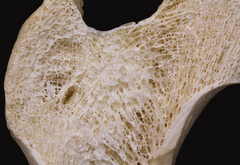Detail, Density, & Contrast (Cram)
1/45
There's no tags or description
Looks like no tags are added yet.
Name | Mastery | Learn | Test | Matching | Spaced |
|---|
No study sessions yet.
46 Terms
Degree of sharpness or definition of an object on a radiograph
Detail
In a radiograph with good detail, what structures can be seen in spongy bone?
Trabeculae

Measure of the amount of radiation absorbed by the object
Density
What is density expressed as a ratio?
Weight/volume
Order these substances from most to least dense? Bone, fat, gas, metal, and water
Metal > Bone > Water > Fat > Gas
Amount of radiation received by the film
Film density
If you reduce the mA by 1/2, what would happen to the film density?
It would be reduced by 1/2
If you reduce the distance to the plate by 1/2, what will happen to the film density?
Note: This is done the same way as inverse square law questions
It would increase by 4 times
1/1/2^2 = 1/0.25 = 4
If your exposed time is doubled, what will happen to the film density?
Increase
If you increase your part/film distance, will you magnify or make your image smaller?
Note: Part/film distance is the distance from the object being radiographed to the plate
Magnify
If you decrease your source image distance will you magnify or make your image smaller?
Magnify
High subject contrast does what to radiographic contrast?
Increased
Anything that permits the penetration and passage of X–rays or other forms of radiation
Radiolucent
Anything that blocks the penetration and passage of X–rays or other forms of radiation
Radiopaque
Will overexposure make your film darker or lighter?
Darker
Will underexposure make your film darker or lighter?
Lighter
Which grid absorbs more radiation: 8:1 or 1:8?
8:1
Defined as the difference between two adjacent dark areas (or between two adjacent white areas) that can beviewed on a radiograph by the naked eye
Contrast
Low kVp produces a short scale contrast, or a long scale contrast?
Short scale contrast
A radiograph shows very white and very black areas, what scale contrast is this?
Short scale contrast
A radiograph shows many areas of grey between white and black areas, what scale contrast is this?
Long scale contrast
Processed film that has not been exposed to ionizing radiation will be what colour?
Remember: Underexposed
Clear/white
What are the eleven factors affecting detail?
- SID
- Part/film distance
- Film/screen contact
- Intensifying screen
- Focal spot
- Pitting of focal spot
- Motion
- Leakage of light
- Improper development
- Improper exposure
- Scatter radiation
What two ways can you improve a penumbra effect without changing the focal spot size?
- Decrease part/film distance
- Decrease source image distance
Fill in the blank: Generally, low range, long scale radiographs are most desirable for _____ _______, short scale most desirable for ________.
soft tissue, bone
The subject contrast of a 5 kg St. Bernard puppy would be different from the subject contrast of a 12 year old 5 kg Pomeranian dog. Why?
Puppy have cartilage growth plates which are less dense than bone
Anode bearing failure and excessively long exposure times being used can cause what kind of damage in the x–ray machine?
Pitting of the focal spot
Do x–rays hitting an object at an angle cause elongation or shortening of the object?
Elongation
Note: This is why we generally want the object at a right angle with the plate. With the exception of oblique view in equine radiology

Focal–film distance (FFD) is more commonly called what?
Source image distance
If having an increased source image distance improves detail, why don't we make the SID as large as space allows?
The larger the SID the more KvP and mAs is required. Distance chosen is a balance between good detail and safety (~76–80cm)
A larger the focal spot will result in more or less detail?
Note: This is the cause of the penumbra effect
Less detail
Larger crystals in the intensifying screen will result in more or less detail?
Less
Fill in the blank: _______ or _______ cassettes result in greater loss of detail.
Damaged, warped
What can you do to increase the detail of your image if your patient is moving alot?
Faster exposure time

What may have caused this ghost–like image during development?Leakage of light
Fill in the blank: Loss of _______ of the x–ray beams intensity results in loss of detail. This is why pitting of the focal spot decreases detail.
uniformity
What are the six factors effecting density?
Remember: My Evil KIDS
Milliamperage
Exposure time
Kilovoltage
Improper development
Density of the object being radiographed
Source–Image distance
If you double the mA how does it effect the density of the film, and is this a direct effect?
Doubles the density of the film, it is a direct effect!
A greater exposure time would mean more or less x–rays hitting the plate?
More
Will increasing the kilovoltage will increase or decrease the film density, and is this a direct effect?
Increase the film density, it is NOT a direct effect
What are the four factors effecting contrast
- Kilovoltage
- Scatter radiation
- Development procedures
- Subject contrast
What is the main factor effecting contrast?
Kilovoltage
Each time film is raised to the safety light some fogging will occur. What is this type of development called?
Sight development. Don't do this!
Defined as the difference in relative densities of a particular subject
Subject contrast
What are some techniques used to alter subject contrast?
Postitive, negative, and double contrast studies
What is the primary exposure factor that controls scatter radiation?
KvP